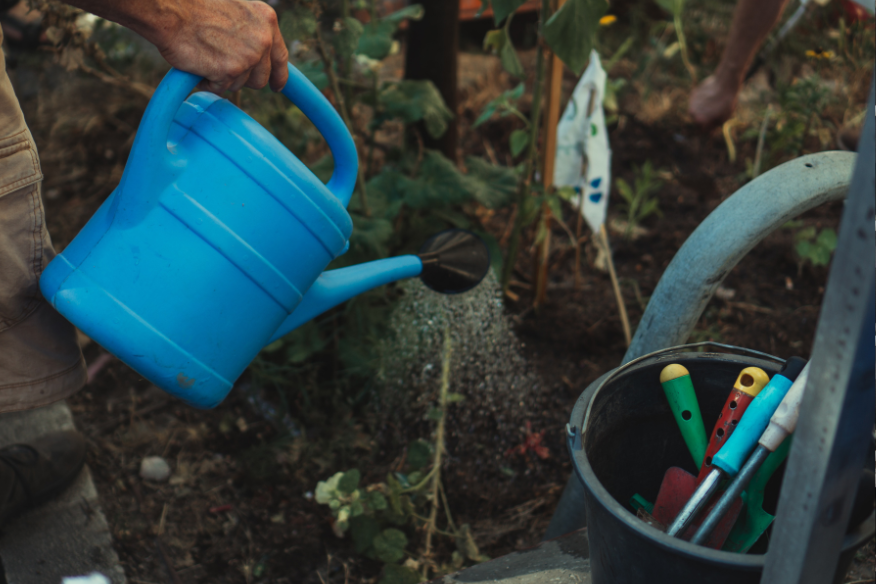Weeds can be a nuisance for any gardener and they can take over your garden if you don’t take action to prevent them. While chemical weed killers are effective, they can also harm the environment, pets, and even humans. Fortunately, there are natural ways to banish weeds without using chemicals. In this article, we will explore 10 natural ways to keep weeds at bay.
Understanding weeds is the first step to getting rid of them. Weeds are unwanted plants that grow in your garden and compete with your desired plants for water, nutrients, and sunlight. Preventative strategies, physical removal techniques, natural herbicides, household items as weed killers, biological control methods, companion planting, and regular garden maintenance are some of the ways you can prevent and control weeds. In this article, we will discuss each of these methods in detail and provide tips on how to use them effectively.
Key Takeaways
- There are natural ways to banish weeds without using chemicals.
- Understanding weeds is the first step to getting rid of them.
- Preventative strategies, physical removal techniques, natural herbicides, household items as weed killers, biological control methods, companion planting, and regular garden maintenance are some of the ways you can prevent and control weeds.
Understanding Weeds
Weeds are unwanted plants that grow in gardens, lawns, and fields. They are often considered a nuisance because they compete with desirable plants for nutrients, water, and sunlight. Weeds can also be unsightly and reduce the aesthetic value of a landscape.
Types of Common Weeds
There are many types of weeds, but some of the most common include:
Annual weeds: These weeds complete their life cycle in one growing season. They reproduce by seed and die at the end of the season. Examples include chickweed, crabgrass, and pigweed.
Perennial weeds: These weeds live for more than one growing season. They can reproduce by seed or vegetatively through their roots or stems. Examples include dandelion, bindweed, and thistle.
Broadleaf weeds: These weeds have wide, flat leaves. Examples include clover, dandelion, and plantain.
Grass weeds: These weeds have narrow leaves and are often difficult to distinguish from desirable grasses. Examples include crabgrass, quackgrass, and foxtail.
Weed Growth Cycle
Understanding the growth cycle of weeds can help you control them more effectively. Weeds typically go through four stages of growth:
Germination: This is when the weed seed begins to grow roots and shoots.
Vegetative growth: During this stage, the weed grows leaves and stems.
Reproductive growth: This is when the weed produces flowers and seeds.
Senescence: This is the final stage of growth, when the weed begins to die off.
By understanding the growth cycle of weeds, you can target them at the most vulnerable stage of their development. For example, pre-emergent herbicides can be applied before weed seeds germinate, while post-emergent herbicides can be applied after the weed has begun to grow.
Preventative Strategies
Soil Health Improvement
One of the most effective ways to prevent weeds from taking over your garden is to improve the health of your soil. Healthy soil provides the nutrients that plants need to grow strong and healthy, which can help them outcompete weeds. Here are a few ways to improve your soil health:
Add organic matter: Compost, leaf mould, and well-rotted manure are all great sources of organic matter that can help improve soil structure, retain moisture, and provide nutrients to plants.
Mulch: A layer of organic mulch like wood chips, straw, or leaves can help suppress weed growth by blocking out light and preventing weed seeds from germinating.
Use cover crops: Planting cover crops like clover, buckwheat, or rye can help improve soil health by adding organic matter, fixing nitrogen, and suppressing weed growth.
Appropriate Plant Selection
Choosing the right plants for your garden can also help prevent weeds from taking over. Here are a few things to consider when selecting plants:
Plant spacing: Crowded plants are more susceptible to weed growth, so be sure to give your plants plenty of space to grow.
Plant height: Taller plants can shade out shorter weeds, so consider planting taller plants in areas where weeds are a problem.
Perennial plants: Perennial plants come back year after year, which can help prevent weed growth by filling in gaps in your garden.
By following these preventative strategies, you can help keep your garden weed-free without relying on harmful chemicals.
Physical Removal Techniques
Hand-Pulling
Hand-pulling is an effective way to remove weeds, especially for smaller areas. It is a simple and straightforward process that involves pulling out the weed by its root. This method is ideal for removing annual weeds, which have shallow roots and are easy to pull out. However, it may not be suitable for perennial weeds, which have deep roots and can regrow if not entirely uprooted.
Mulching Methods
Mulching is another physical removal technique that can help prevent weed growth. Mulching involves covering the soil with a layer of organic material, such as leaves, grass clippings, or wood chips. This layer acts as a barrier, preventing sunlight from reaching the weeds and inhibiting their growth. Mulching also helps to retain moisture in the soil, which can benefit the plants you want to grow.
Solarisation Process
Solarisation is a method that involves using the sun’s heat to kill weeds. This technique is ideal for larger areas, such as gardens or fields. It involves covering the soil with a clear plastic sheet and leaving it in place for several weeks during the hottest part of the year. The heat trapped under the plastic sheet kills the weeds and their seeds, preventing them from regrowing. This method is effective for both annual and perennial weeds.
Overall, physical removal techniques are an excellent way to banish weeds without using chemicals. They are environmentally friendly and can be easily implemented in any garden or field. However, it is essential to ensure that all parts of the weed are removed to prevent regrowth.
Natural Herbicides
Weeds can be a nuisance in any garden or lawn, but using chemical herbicides can have negative effects on the environment and human health. Fortunately, there are several natural alternatives that can help banish weeds without the use of harmful chemicals.
Vinegar Solutions
Vinegar is a natural herbicide that can be used to kill weeds. The acetic acid in vinegar works by drying out the leaves of the weed, causing it to wilt and die. To make a vinegar solution, mix one part vinegar with one part water and a few drops of dish soap. The dish soap helps the solution stick to the leaves of the weed. Spray the solution directly onto the leaves of the weed, being careful not to spray any nearby plants or grass.
Salt and Soap Mixtures
Salt is another natural herbicide that can be used to kill weeds. When salt is applied to the soil, it dehydrates the plant and makes it impossible for it to absorb water. To make a salt and soap mixture, mix one cup of salt with two cups of water and a few drops of dish soap. Spray the solution directly onto the leaves of the weed, being careful not to spray any nearby plants or grass.
It is important to note that while these natural herbicides are effective at killing weeds, they can also harm other plants and grass in the area. It is important to use them sparingly and only on the weeds that need to be removed. Additionally, it is important to wear protective clothing and gloves when using these solutions to avoid skin irritation.
Household Items as Weed Killers
There are a variety of household items that can be used as effective weed killers without resorting to harmful chemicals. Here are two natural methods that can be used to banish weeds from your garden.
Boiling Water Technique
Boiling water is a simple and effective way to kill weeds without using any chemicals. Simply boil a pot of water and pour it over the weeds you want to eliminate. The hot water will scorch the leaves of the weeds, causing them to wither and die. This method is especially effective for killing weeds that grow in cracks in your driveway or between pavers on your patio.
Baking Soda Applications
Baking soda is another household item that can be used to kill weeds. Mix baking soda with water to create a paste, then apply the paste directly to the leaves of the weeds you want to eliminate. The baking soda will dry out the leaves of the weeds, causing them to die off. This method is particularly effective for killing weeds that grow in the cracks of your driveway or sidewalk.
Using household items as weed killers is a safe and effective way to keep your garden free of weeds without resorting to harmful chemicals. These natural methods are easy to use and can be just as effective as chemical weed killers.
Biological Control Methods
Biological control methods are an effective way to control weeds without using harmful chemicals. These methods use natural enemies of weeds to keep them in check. In this section, we will discuss two types of biological control methods: beneficial insects and natural predators.
Beneficial Insects
Beneficial insects are insects that feed on weeds and help to control their growth. Some common beneficial insects include ladybirds, lacewings, and hoverflies. These insects can be attracted to your garden by planting flowers that provide nectar and pollen. They can also be purchased and released into your garden.
Natural Predators
Natural predators are animals that feed on weeds. Some common natural predators include birds, rodents, and reptiles. These animals can be attracted to your garden by providing them with habitats such as birdhouses and rock piles. They can also be encouraged to stay in your garden by providing them with food sources such as seeds and insects.
Using biological control methods is a safe and effective way to control weeds in your garden. By attracting beneficial insects and natural predators, you can reduce the need for harmful chemicals and keep your garden healthy and thriving.
Companion Planting
Companion planting is a natural way to control weeds and pests in your garden. This method involves planting different types of plants together, which can help to repel insects and prevent weed growth.
For example, planting marigolds alongside your vegetables can help to repel pests such as aphids and whiteflies. Similarly, planting mint near your tomatoes can help to deter pests such as spider mites and aphids.
Companion planting can also help to improve soil health. Certain plants, such as legumes, can fix nitrogen in the soil, which can help to improve soil fertility and reduce the need for synthetic fertilizers.
In addition, planting a variety of plants can help to attract beneficial insects such as bees and butterflies, which can help to pollinate your plants and control pest populations.
By using companion planting, you can reduce the need for chemical pesticides and herbicides, which can be harmful to the environment and your health. Plus, it’s a natural and sustainable way to keep your garden healthy and thriving.
Regular Garden Maintenance
Regular garden maintenance is an essential part of keeping weeds at bay. By taking a few simple steps, you can prevent weeds from taking hold and keep your garden looking its best. Here are some tips:
Mulch: Mulching your garden beds with organic materials such as compost, straw, or shredded leaves can help prevent weeds from growing. Mulch helps to smother weed seeds and prevents them from germinating. It also helps to retain moisture in the soil, which is beneficial for your plants.
Pull weeds by hand: Regularly pulling weeds by hand is an effective way to keep them under control. Be sure to pull weeds before they have a chance to go to seed, as this will prevent them from spreading.
Prune and trim: Pruning and trimming your plants can help to prevent weeds from growing. By removing dead or diseased plant material, you can reduce the likelihood of weeds taking hold.
Water wisely: Watering your plants deeply and infrequently can help to prevent weeds from growing. Shallow watering encourages weed growth, as it creates moist conditions that weed seeds thrive in.
Rotate your crops: Rotating your crops can help to prevent the build-up of weed seeds in your soil. By planting different crops in different areas of your garden each year, you can reduce the likelihood of weeds taking hold.
By following these simple tips, you can keep your garden looking its best and banish weeds without the use of harmful chemicals.
Questions & Answers
Permanently eliminating weeds without chemicals can be challenging, but there are some effective methods. One of the best ways is to manually remove weeds by pulling them out by the roots. Another option is to smother them by covering them with a layer of mulch or newspaper. You can also use a propane torch to burn weeds, but this method can be dangerous and should be used with caution.
The most cost-effective natural solution for weed control in gardens is to use mulch. Mulch is made from organic materials such as leaves, grass clippings, or wood chips and helps to prevent weeds from growing by blocking sunlight. It also helps to retain moisture in the soil and improves soil health.
There are several natural strategies you can use to prevent weeds from growing in your vegetable patch. One of the most effective is to use a weed barrier, such as landscape fabric, to cover the soil. You can also plant vegetables closer together to create a dense canopy that shades out weeds. Additionally, you can use organic mulch to cover the soil and prevent weed growth.
To remove weeds from pavement cracks, you can use a mixture of vinegar and salt. Mix one gallon of vinegar with one cup of salt and apply the solution to the weeds. The vinegar will kill the weeds, and the salt will prevent them from growing back. You can also use a propane torch to burn the weeds, but be careful not to damage the pavement.
To tackle garden weeds without harming your lawn, you can use a weed puller to manually remove the weeds. Another option is to use a homemade weed killer made from vinegar, salt, and dish soap. This solution is effective at killing weeds but will not harm your lawn. You can also use a hoe to chop off the tops of the weeds, which will prevent them from spreading their seeds.
There are several homemade concoctions that are effective at naturally exterminating weeds. One of the most popular is a mixture of vinegar, salt, and dish soap. Another option is to use boiling water to kill weeds. You can also use a mixture of baking soda and water to kill weeds. However, be careful when using these solutions, as they can also harm desirable plants.




